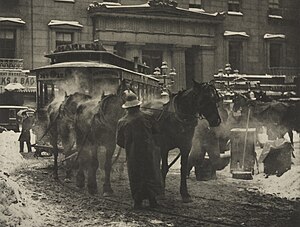Form and content
From WikiEducator
| Art Appreciation and Techniques (#ART100) | |
|---|---|
| Artistic media: The camera arts | Overview | Introduction | Early development | Impact on other media | Form and content | Darkroom processes | The human element | Color images | Photojournalism | Modern developments | Film, video and digital | Summary |
The darkroom became the studio of the photographer. It was there where visual ideas translated into images: an opportunity to manipulate the film negative, to explore techniques and discover the potential the photograph had in interpreting objects and ideas.

Alfred Stieglitz, The Terminal, 1892
Other photographs by Stieglitz concentrate on more conceptual ideas. His series of cloud photos, called Equivalents, are efforts to record the essence of a particular reality, and to do it “so completely, that all who see [the picture of it] will relive an equivalent of what has been expressed”. His Equivalents photos establish a new level for the aesthetic content of ideas, and are essentially the first abstract photographs.